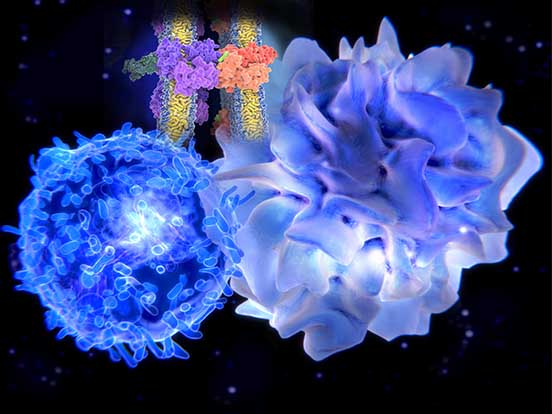
Killer-cell Immunoglobulin-like Receptors
High quality recombinant KIRs for your research
Killler-cell immunoglobulin-like receptors (KIRs) are a family of highly polymorphic receptors expressed on the surface of natural killer (NK) cells and a subset of T cells. By interacting with major histocompatibility (MHC) class I molecules, which are expressed on all cell types, they work to regulate the killing function of NK cells.
AMSBIO supplies a range of high quality KIR recombinant proteins, ideal for use as antigens and in protein binding studies.
Features
Functions of KIRs
The majority of KIRs are inhibitory, meaning that binding to their MHC class I ligands suppresses the cytotoxic activity of NK cells. This is crucial to ensure that the immune system doesn’t attack healthy cells in the body. MHC-I expression is down-regulated in certain tumor and virus-infected cells, therefore lack of binding to KIRs, combined with binding to several other activating receptors allows NK cells to attack these abnormal cells. A limited number of KIRs are activating, meaning that their recognition of MHC molecules activates the cytotoxic activity of their cell.
As a result of KIR's role in killing unhealthy self-cells and not killing healthy self-cells, KIRs are involved in protection against and propensity to viral infection, autoimmune disease, and cancer.

Our Products
Applications
Goodridge et al (2019) shows that educated NK cells expressing self-MHC specific inhibitory KIR accumulate granzyme B and Chondroitin Sulfate-4 in dense-core secretory lysosomes that converge close to the centrosome, as demonstrated by AMSBIO’s chondroitin sulfate stub antibodies.



Left: Representative immuno-EM section showing staining with gold-particle coated anti-Chondroitin Sulfate-4 (CS-4) stub antibody of NK cells expressing non-self or self KIR. Center: Number of gold particles (CS-4) per cell. Right: Density of gold particles (CS-4) per lysosomal area (μm2). From Goodridge et al (2019), reproduced under Creative Commons Attribution 4.0 International License)
Citations
Remodeling of secretory lysosomes during education tunes functional potential in NK cells
Goodridge, J.P., et al (2019) Nat. Comm. 10(1): 514
